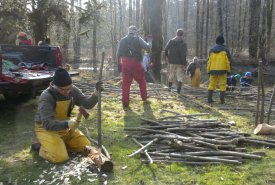Our work
In 1974, the Nature Conservancy of Canada's (NCC's) acquisition of Mud Bay marked our first project in British Columbia. Since then, we have completed over 100 projects in this province, helping to conserve almost 1 million acres (400,000 hectares) of lands and waters.
We focus our conservation work in priority areas, identified through science-based planning initiatives. These are areas where healthy habitats for animals, plants and people face the greatest threats.
In British Columbia, we work in three program areas. Each program area encompasses several smaller priority natural areas. Together, these landscapes span the wide range of habitats and ecosystems that make BC unique.
Our work in BC is supported by our regional advisory board. This dynamic group of professionals brings expertise that touches on all aspects of our conservation work, volunteering their time to help NCC make the best decisions for conservation across all of our program areas.

West Coast
Abundant marine life, lush forests and a mild climate characterize this incredible region of BC. NCC is actively engaged along the length of the West Coast, from the busy and densely populated Salish Sea region to Haida Gwaii.
Learn more about our work in this region >
Interior
From the Okanagan and Similkameen to the Thompson-Nicola Valley, NCC works with ranchers, naturalists, biologists, businesses, governments and individuals to protect the Interior's biodiversity. Special climate and conditions make much of the grassland, open forest and wetland here globally distinct.
Learn more about our work in this region >
Canadian Rockies
BC's Rocky Mountain region encompasses formidable mountains, fertile valleys and an extensive network of lakes and rivers. NCC's largest conservation area is found here, as are many expansive wildlife corridors. This is a place in which conservation can, and should, think big.
Learn more about our work in this region >
Stewardship and restoration

Conservation Volunteers at work stabilizing stream banks (Photo by NCC)
Our work doesn't end once a property is protected. Detailed management plans guide how we monitor the land's long-term health and resiliency.
Field staff work with dedicated volunteers to tackle ongoing maintenance like invasive plant removal and habitat enhancement. In some cases our team undertakes extensive restoration of degraded sites to rehabilitate the land's natural ecology.





